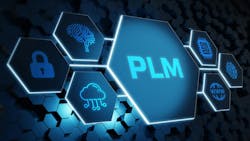Removing the risk from PLM: Approaches now to secure your digital transformation
In the current age of constant digital transformation, new products and versions are rolled out in regular iterations to satisfy consumer demands. To keep up with this demand, it’s important to have a product lifecycle management (PLM) solution that can move with agility without exposing your organization to unnecessary risk in the process.
Unfortunately, many PLM systems and processes lack the inherent features necessary to keep up with the evolving threat landscape and risks that come with it. Organizations as a result may need to undertake special measures to modernize and de-risk their PLM strategies moving forward.
See also: Manufacturers should view emerging tech as relief from the workforce crunch
PLM systems face a range of risks and challenges, both new and old, especially as cybersecurity and other technologies evolve. Some of the greatest risks and threats facing PLM systems:
- Data breaches and IP theft: PLM systems house sensitive product data, designs, and technical specs, making them prime targets for cyberattack. A single significant data breach can lead to reputational damages, data loss, expensive ransoms, and legal problems.
- User errors: Whether intentional or not, user errors and misconfigurations can enable unauthorized use and manipulation of important tools and assets. Preventing user error is particularly challenging when dealing with workforce shortages and overworked or undertrained IT teams.
- Growing global workforces: The increasing global distribution of teams makes it difficult to ensure all employees have real-time, secure access to PLM systems and data they need. Global and remote workforces also complicate how organizations establish uniform security and access management rules that work across the board.
- Changing business processes and expectations: Mergers and acquisitions; new global, regional, or industry-specific regulations; internal product changes and updates; and changing customer demands can all put pressure on outdated and “legacy” PLM systems that may no longer align with what your organization’s needs.
- Natural disasters and unexpected events: Disasters and crises, such as COVID-19’s disruption of the supply chain and increasing global political instability, have reminded business leaders of the volatility of their systems, workflows, and resources.
- AI and emerging technologies: In recent months and years, the stunning growth of AI technology has brought forth new concerns about how data is sourced and used and how hackers may develop more sophisticated and undetectable attack vectors.
See also: Podcast: Accessing data and clearer paths to drive your digital transformation
Though it’s impossible to eliminate all risks that may impact your business’s PLM environment, going through an intentional de-risking process can greatly decrease and even eradicate major issues.
De-risking should not be viewed merely as a one-time checkbox activity. Instead, de-risking should be a long-term, ongoing project in which your organization’s leaders frequently assess the work you’re doing, the environment you’re operating, any third-party variables that impact performance and security, and other factors that may alter your risk posture over time.
This involves identifying your critical system features and resources and then developing an appropriate protection and risk management strategy specifically for these vital assets.
Key steps to kickstart a comprehensive de-risking program for a PLM system:
Step 1: Migrate to and modernize for the cloud
Many manufacturers and other users of PLM technology have long operated with on-premises, legacy software. Until recently, there was significant hesitation about shifting to the cloud and exposing product data to whatever security and compliance issues may be lurking in a third-party, managed environment.
However, a growing number of PLM users are moving to the cloud, as major cloud computing leaders like Azure, Amazon Web Services, and Google Cloud Platform have proven to be agile partners that support scalable operations in elastic, secure environments.
See also: Future-proofing your operations: Automation support through the looming labor crisis
As part of your cloud migration project, you’ll likely need to modernize existing apps and components of your PLM system. Before this initial lift-and-shift to the cloud, it’s best to take the time necessary to develop elastic, low-code applications, components, and containers that will integrate smoothly with cloud infrastructure and be easy to reconfigure and update as product lifecycles and workflows change day by day.
Step 2: Set up a comprehensive cybersecurity posture
Many of the most serious and damaging risks PLM platforms encounter stem from cybersecurity breaches and related issues. Rather than reacting defensively after a successful attack has already been launched, businesses following a de-risking program should establish security protections and training to proactively prepare for this kind of scenario.
Some of the best cybersecurity solutions for PLM environments include identity and access management tools, data encryption that works at rest and in transit, and web application firewalls. Penetration testing and other offensive security preparations also can help your team identify and mitigate issues before they turn into something bigger.
Step 3: Protect your data
De-risking should focus not only on the whole PLM system but also on the data and IP housed in that system. As part of your de-risking plan, prepare to conduct regular data backups and set up clear disaster recovery best practices for business continuity in various worst-case scenarios.
Even if the PLM is on the cloud and the responsibility of these processes falls to the third-party provider, the PLM owner needs to be responsible for clearly understanding the cloud service level agreement they have agreed to and be an active participant in recovery exercises with the provider.
See also: Air gapping OT assets may be the only sure way to shield critical infrastructure
In addition to setting up data security tools and solutions, protect your data by setting specific rules for the people who work with it. Data access should be limited to pre-approved, vetted users, and these users should receive comprehensive training on when and how to use sensitive data sources to prevent avoidable errors and misconfigurations.
Step 4: Establish least privilege access
No matter how much you trust the people you work with and employ, one of the most common causes of system and security issues on a PLM platform is user error or the unauthorized sharing of user credentials.
With least privilege access, the platform, its apps, data and data stores, and other important resources are set up so only the users who need access are granted access on an item-by-item and case-by-case basis. This limits a significant amount of risk, both internally and externally.
Step 5: Foster a DevOps culture
Implementing DevOps as a de-risking strategy not only enhances product outcomes and efficiencies but also fosters a strategic organizational approach. DevOps facilitates the collaboration of team members who have typically worked in silos on opposite ends of the product lifecycle.
This collaborative approach enhances the likelihood of uncovering long-term solutions that address challenges from all sides and perspectives. Using DevOps processes should include the automation of continuous integration, testing and continuing deployment processes ensuring a minimal number of people are involved with the process, reducing the risk of human error.
See also: Inside the Rockwell, Church & Dwight OT cybersecurity team-up
To effectively address the challenges posed by digital transformation, organizations must prioritize the modernization and de-risking of their PLM systems.
Through strategies such as cloud migration, comprehensive cybersecurity measures, data protection protocols, access control, and fostering a DevOps culture, companies can navigate the complexities of digital evolution and secure their PLM systems against emerging threats, ensuring resilience and continuity within the ever-changing business environment.
About the Author

Bruce Bookbinder
Bruce Bookbinder is a product marketing manager at Aras, where he is driving marketing strategy for the company's cloud and SaaS deployments as well as other technical aspects of its PLM platform. He has held several IT management and technology positions at General Electric, Avon Products, Reader’s Digest, and Control Data Corp. prior to his time at Aras.
